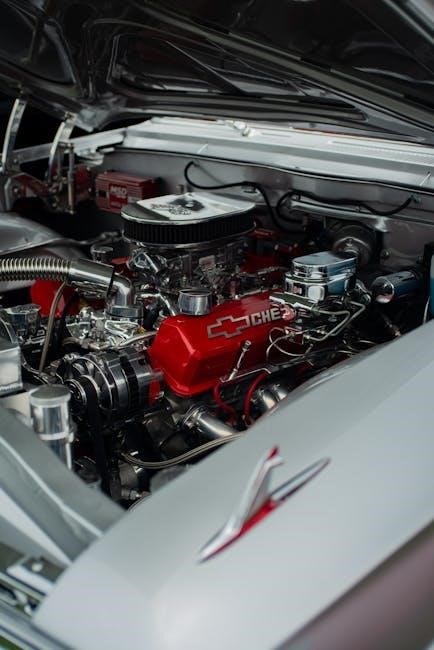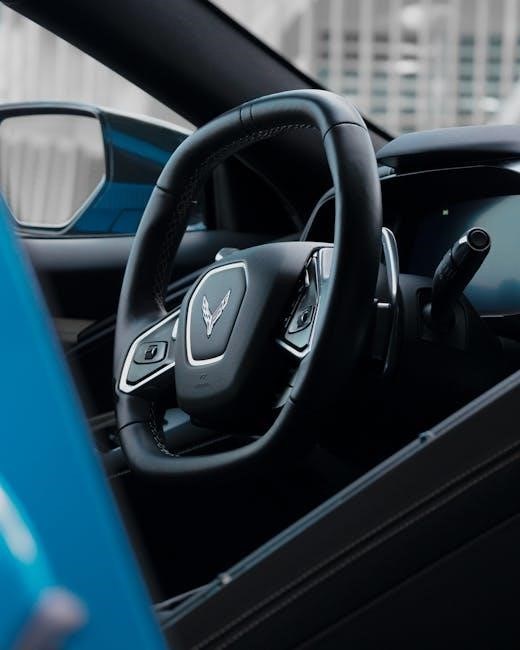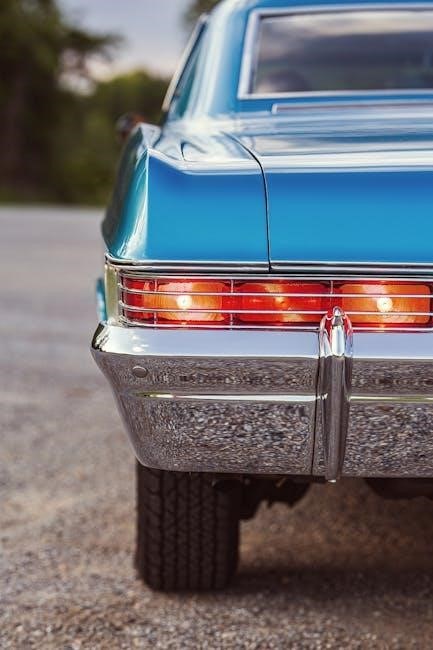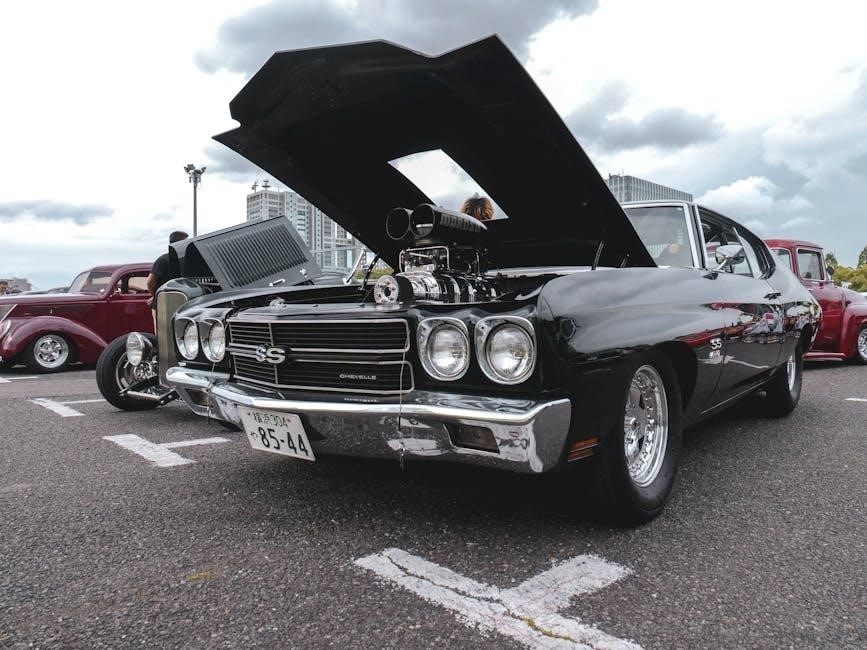2014 Chevy Cruze Diesel Engine Overview
The 2014 Chevy Cruze Diesel offers a blend of efficiency and performance. Its engine provides a sophisticated driving experience with a non-gimmicky design. The Cruze also features a large trunk for a compact sedan‚ making it practical.
Key Features and Benefits
The 2014 Chevy Cruze Diesel boasts several key features that contribute to its appeal. Its diesel engine offers enhanced fuel efficiency compared to gasoline counterparts‚ making it an economical choice for daily commuting and long drives. The turbocharger provides ample torque for confident acceleration and passing power. The Cruze’s refined suspension system delivers a comfortable and controlled ride‚ enhancing the overall driving experience. Inside‚ the cabin is well-appointed with user-friendly technology and comfortable seating. Safety features are also a priority‚ providing peace of mind for drivers and passengers. Overall‚ the 2014 Cruze Diesel offers a compelling package of efficiency‚ performance‚ and comfort.
Engine Components and Functionality
The 2014 Chevy Cruze diesel engine combines multiple critical elements. These parts work to deliver power efficiently. Understanding these elements helps to comprehend the engine’s smooth functioning and overall performance.
Major Engine Parts
The 2014 Chevy Cruze Diesel engine comprises several key components that work in unison. These include the turbocharger‚ which boosts power and efficiency. The common rail fuel injectors precisely deliver fuel for optimal combustion. The exhaust gas recirculation (EGR) system reduces emissions. The engine coolant radiator maintains optimal operating temperature.
Other important parts consist of the cylinder head‚ pistons‚ crankshaft‚ and camshaft. These elements contribute to the engine’s mechanical operation. Understanding their interactions is crucial for effective maintenance and repair. A detailed engine parts diagram provides a visual representation of these components. This diagram is important for identifying and locating parts. Accessing these diagrams aids in comprehending the engine’s structure and functionality.
Fuel Efficiency and Performance
The 2014 Chevy Cruze Diesel balances fuel efficiency with respectable performance. Its diesel engine offers enhanced torque for responsive acceleration. The turbocharger plays a crucial role in optimizing power delivery. The engine’s design contributes to efficient combustion. This efficiency allows for considerable fuel savings.
The Cruze Diesel provides a compelling alternative to gasoline-powered compact cars. It’s known for its ability to achieve impressive mileage. This fuel efficiency makes it a practical choice for daily commuting and long drives. The engine’s performance characteristics make it suitable for various driving conditions. Drivers appreciate the combination of power and economy that the Cruze Diesel offers. Its refined engine design allows for a smooth and efficient driving experience.
2.0L Turbo Diesel Engine (LUZ)
The 2.0L Turbo Diesel LUZ engine powers the 2014 Chevy Cruze Diesel. It offers notable fuel efficiency and performance. This engine incorporates advanced diesel technology‚ making it a standout choice.
Specifications and Detailed Information
The 2.0L Turbo Diesel (LUZ) engine in the 2014 Chevy Cruze Diesel is a sophisticated piece of engineering. It is designed to provide a balance of power and fuel economy. This engine features a turbocharger to enhance performance and efficiency. Detailed specifications include its displacement‚ horsepower‚ and torque ratings‚ all contributing to its responsive driving dynamics. The engine’s design incorporates advanced fuel injection technology. This system optimizes combustion and reduces emissions. Further information covers its construction materials‚ dimensions‚ and weight. Accessing comprehensive specifications helps owners and technicians understand its capabilities. This detailed insight supports effective maintenance and repair procedures. Understanding the nuances of this engine ensures optimal vehicle operation and longevity‚ providing a reliable and efficient driving experience.
Applications in Chevy Cruze Diesel
The 2.0L Turbo Diesel engine (LUZ) finds its primary application in the 2014 Chevy Cruze Diesel model. Specifically designed for this compact sedan‚ it offers enhanced fuel efficiency. It provides a driving experience superior to its gasoline counterparts. The engine’s integration into the Cruze platform was carefully engineered. It optimizes the vehicle’s overall performance and capabilities. Furthermore‚ it ensures seamless compatibility with other systems. This includes the transmission‚ exhaust‚ and cooling systems. This makes it ideal for drivers seeking a blend of economy and performance in a compact vehicle. The 2014 Cruze Diesel utilizes the engine’s torque characteristics. This provides responsive acceleration and confident highway cruising. The 2.0L diesel delivers efficient operation. This helps make it a practical and enjoyable choice for daily commutes and long trips.

Engine Wiring Diagram and Schematics
Accessing and comprehending the engine wiring diagrams and schematics for the 2014 Chevy Cruze Diesel is crucial for effective maintenance. It is also crucial for the repair work on the vehicle.
Accessing Wiring Diagrams
For the 2014 Chevy Cruze Diesel‚ obtaining the correct engine wiring diagrams is essential for troubleshooting and repair. Service repair manuals often contain these diagrams. Online resources and forums dedicated to the Chevy Cruze can also provide access to wiring schematics. These diagrams are valuable for understanding the electrical connections within the engine and related systems.
Repair Surge offers a comprehensive service manual. Accessing these resources ensures accurate information derived from the original manufacturer’s service materials‚ aiding in precise diagnostics and repairs. Wiring diagrams are available for free download as PDF files. Some forums dedicated to the Cruze may also have shared diagrams.
Understanding Wiring Diagrams
Interpreting wiring diagrams for the 2014 Chevy Cruze Diesel requires familiarity with automotive electrical symbols and conventions. Diagrams illustrate the connections between various engine components‚ sensors‚ and control modules. Tracing circuits helps identify potential issues such as shorts‚ open circuits‚ or faulty components. Understanding the color coding of wires is also crucial for accurate diagnosis.
A wiring diagram acts as a roadmap of the electrical system‚ showing how different parts of the engine connect and interact. By understanding these diagrams‚ technicians can pinpoint problems and make necessary repairs effectively. These diagrams are essential for any electrical work on your vehicle.

Cooling System
The 2014 Chevy Cruze Diesel cooling system is essential for maintaining optimal engine temperature. It uses a radiator and coolant to dissipate heat‚ preventing overheating and engine damage during operation.
Engine Coolant Radiator
The engine coolant radiator in the 2014 Chevy Cruze Diesel is a crucial component of the cooling system. TRQ manufactures a top-grade cooling radiator designed to meet demanding customer requirements‚ ensuring the engine remains in top condition. This radiator is built to fit and function correctly. It also brings the vehicle back to its original state‚ providing a budget-friendly alternative to the OEM part.
Maintaining the correct temperature of the engine is important for optimal performance and longevity. The radiator effectively dissipates heat‚ ensuring that the engine operates within its ideal temperature range. A properly functioning radiator prevents overheating‚ which can lead to severe engine damage. Regular inspection and maintenance of the radiator are important to ensure continued reliability.
Fuel Injection System
The fuel injection system in the 2014 Chevy Cruze Diesel is designed for efficiency. It helps increase fuel efficiency and deliver the needed power. The system ensures optimized combustion and reduces emissions.
Turbocharger Functionality
The 2014 Chevy Cruze Diesel utilizes a turbocharger to enhance engine performance. This turbocharger is designed to provide extra power and torque. The turbocharger helps the engine overcome challenges on the road by improving acceleration and responsiveness. It works by forcing more air into the engine’s cylinders‚ allowing for increased combustion and power output.
The turbocharger is a critical component for achieving a balance between fuel economy and performance in the Cruze Diesel. It allows the engine to deliver sufficient power when needed while maintaining efficiency during normal driving conditions. The system’s design is optimized to provide a smooth and consistent power delivery.
Common Rail Injectors
The 2014 Chevy Cruze Diesel employs common rail injectors as part of its fuel injection system. These injectors are solenoid-based‚ providing precise control over fuel delivery to the engine cylinders. Common rail technology allows for high-pressure fuel injection‚ which improves combustion efficiency and reduces emissions. The injectors are designed to deliver fuel in a fine mist‚ ensuring thorough mixing with air for optimal burning.
This precise fuel delivery contributes to the engine’s overall performance and fuel economy. The common rail system helps to minimize fuel waste and maximize power output. Proper functioning of these injectors is crucial for the engine’s smooth operation and longevity.
Exhaust Gas Recirculation (EGR) System
The 2014 Chevy Cruze Diesel is equipped with an Exhaust Gas Recirculation (EGR) system. This system plays a crucial role in reducing nitrogen oxide (NOx) emissions. The EGR system works by recirculating a portion of the exhaust gas back into the intake manifold. This process lowers combustion temperatures‚ which in turn reduces the formation of NOx.
The EGR system is essential for meeting emission standards and ensuring environmentally friendly operation. Its components include valves‚ sensors‚ and control units that work together to regulate the amount of exhaust gas recirculated. Proper maintenance of the EGR system is important for optimal engine performance.

Maintenance and Repair
Maintaining your 2014 Chevy Cruze Diesel ensures longevity. Service repair manuals offer procedures‚ specs‚ and wiring diagrams. These resources aid in diagnosing and fixing potential issues‚ keeping your vehicle in top condition.
Service Repair Manuals
Accessing service repair manuals for your 2014 Chevy Cruze Diesel is crucial for proper maintenance and troubleshooting. These manuals offer comprehensive information‚ including detailed job instructions‚ mechanical and electrical fault diagnostics‚ technical modifications‚ and essential wiring diagrams. Utilizing these manuals ensures accurate repairs based on the manufacturer’s original service materials.
A reliable service manual contains procedures‚ specifications‚ part numbers‚ illustrations‚ and wiring schematics. Whether you’re performing routine maintenance or tackling complex repairs‚ these manuals provide the necessary guidance. They are the ultimate reference for both experienced mechanics and new owners seeking to understand their vehicle better. This access will ensure safety!

Potential Problems
Owners of the 2014 Chevy Cruze Diesel may encounter issues such as fuel leaks‚ particularly around the injectors. Addressing these potential problems promptly is crucial to maintain engine performance and prevent further damage.
Fuel Leaks
Fuel leaks in the 2014 Chevy Cruze Diesel can pose a significant risk. They often occur on top of the engine‚ near the turbocharger‚ which is a very hot area. Injectors may be the source of these leaks. Solenoid common rail injectors are used in this vehicle. It is crucial to address fuel leaks immediately to prevent potential fires or damage to engine components. Regular inspection of the fuel system‚ especially around the injectors‚ is highly recommended. Promptly repairing any leaks will ensure safe and efficient operation of the engine.
